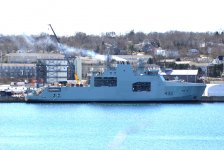Nope. Fake news. 2m thick ice is obviously slush breaking. These things are terrible and will never sail in ice. /sarcasm
Had a nice briefing from Cdr Gleason commissioning CO of Harry DeWolf the other day. Some tidbits from their historic circumnavigation of North America.
- with embarked DRDC folks and HDW deployed TRAPS as a trial. It is the most northern usage of a towed ASW sonar array from a ship in RCN history and given some research no other NATO ship has used a towed array that far north either.
- HDW was supposed to take on fuel twice on their trip. The first time the refueling ship had a mechanical issue and couldn't make it. The second time they were stopped by weather. HDW did all of their missions and traveled from Halifax to Esquimalt on a single tank of gas. Apparently, the fuel economy estimations were conservative. It was a very pleasant surprise as it allowed HDW to carry on with the mission despite the challenges and reduces operating costs for the ship quite a bit.
- At no time was Cdr Gleason worried about the safety of the ship through the ice they encountered. The trials in Feb 2021 proved the ship can handle just about anything ice-wise during that time of year.
- They had CCG helicopters do touch and go for trials.
- The trip to Esquimalt including stops for their missions (amphib operations with Rangers, community outreach, TRAPS, RMP, etc...) took 53 days (again single tank of gas). The facilities onboard were sufficient and the crew was pretty comfortable. Apparently, they converted the OPS room into a games room, and despite being at sea for that long on some really boring stretches they didn't get to stir crazy.
- The embarkation of USCG folks for OP Caribbe was a success, with lots of space available for the boarding team and their gear.
- There were some lessons learned about cooling in the Carib. It's a bit uneven on the ship (the bridge wore sweaters, some parts of the ship were quite warm). There are some EC's submitted to look into that. Interestingly the ship didn't have heating issues in the arctic.
- They took on three Humanitarian Relief containers in the US to trail the process.
Those are the high points I could remember. Really a very interesting briefing. So far the ship generally is performing at expectations with some pleasant surprises and some things that need fixing. RCN seems excited about what capabilities they are getting with the ship as its potential is being explored.




